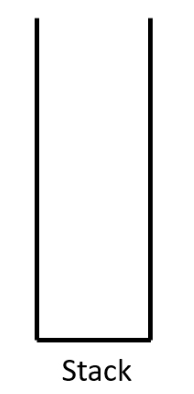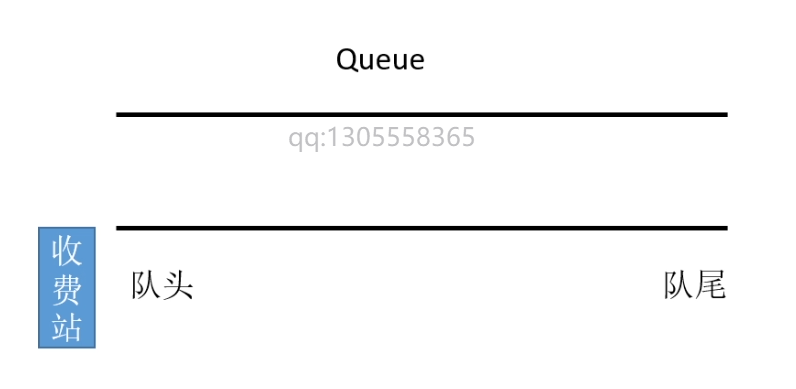栈的应用
栈(Stack):是一种后进先出的数据结构 只能一端进行添加(入栈)或删除(出栈)操作,这一端称为栈顶。
栈的相关操作
Stack
void Push(e) //往栈中添加元素 E Pop() //将栈顶的元素取出删除 E Peek() //查询栈顶的元素 int Count //栈中的元素有多少 Bool IsEmpty //栈是否为空
Array1底层代码:
//第一版常规数组类class Array1<E{private E[] data; //存储元素的数组private int N; //数组中的元素个数//通过指定容量开辟数组空间public Array1(int capacity){data = new E[capacity];N = 0;}//默认数组容量为10public Array1() : this(10) { }//获取数组容量的属性public int Capacity{get { return data.Length; }}//获取数组元素个数的属性public int Count{get { return N; }}//判断数组是否为空的属性public bool IsEmpty{get { return N == 0; }}//在数组指定位置添加元素epublic void Add(int index, E e){if (index < 0 || index > N)throw new ArgumentException("数组索引越界");if (N == data.Length)ResetCapacity(2 * data.Length);for (int i = N - 1; i >= index; i--)data[i + 1] = data[i];data[index] = e;N++;}//在数组尾部添加元素epublic void AddLast(E e){Add(N, e);}//在数组头部添加元素epublic void AddFirst(E e){Add(0, e);}//获取指定位置的元素epublic E Get(int index){if (index < 0 || index >= N)throw new ArgumentException("数组索引越界");return data[index];}//获取数组头部的元素epublic E GetFirst(){return Get(0);}//获取数组尾部的元素epublic E GetLast(){return Get(N - 1);}//修改数组中的值public void Set(int index, E newE){if (index < 0 || index >= N)throw new ArgumentException("数组索引越界");data[index] = newE;}//查询数组是否包含元素epublic bool Contains(int e){for (int i = 0; i < N; i++){if (data[i].Equals(e))return true;}return false;}//查询数组中元素e的位置索引public int IndexOf(int e){for (int i = 0; i < N; i++){if (data[i].Equals(e))return i;}return -1;}//删除指定位置的元素并返回该元素public E RemoveAt(int index){if (index < 0 || index >= N)throw new ArgumentException("索引超出了数组界限");E del = data[index];for (int i = index + 1; i <= N - 1; i++)data[i - 1] = data[i];N--;data[N] = default(E);if (N == data.Length / 4)ResetCapacity(data.Length / 2);return del;}//删除数组头部位置的元素并返回该元素public E RemoveFirst(){return RemoveAt(0);}//删除数组尾部位置的元素并返回该元素public E RemoveLast(){return RemoveAt(N - 1);}//删除指定的元素epublic void Remove(int e){int index = IndexOf(e);if (index != -1)RemoveAt(index);}//调整数组容量的大小private void ResetCapacity(int newCapacity){E[] newData = new E[newCapacity];for (int i = 0; i < N; i++)newData[i] = data[i];data = newData;}//输出链表类的信息public override string ToString(){StringBuilder res = new StringBuilder();//res.Append(string.Format("Array1: count={0} capacity={1}\n", N, data.Length));res.Append("[");for (int i = 0; i < N; i++){res.Append(data[i]);if (i != N - 1)res.Append(", ");}res.Append("]");return res.ToString();}}
在数组栈中添加元素,删除栈顶的元素,其例子
要点:我们应该将栈的尾部还是头部作为栈顶? 从时间复杂度来看: (1)如果将头部作为栈顶,需要两步,将头部删除后,再把后面的元素的向前移(第一个不在了,那就将第二设为第一,第三设为第二,以此类推) 0(N) (2)如果将尾部作为栈顶,只需一步,删除尾部,其他的元素的位置不用进行改变 0(1) IStack
——>** 接口 Array1——>底层代码(数组)**
class ArrayIstack<E>:IStack<E>
{
private Array1<E> arr;
public ArrayIstack(int capacity)
{
arr = new Array1<E>(capacity);
}
public ArrayIstack()
{
arr = new Array1<E>();
}
/// <summary>
/// 返回栈中的元素有多少
/// </summary>
public int Count { get { return arr.Count; } }
/// <summary>
/// 栈是否为空
/// </summary>
public bool IsEmpty { get { return arr.IsEmpty; } }
/// <summary>
/// 查询栈顶的元素
/// </summary>
/// <returns></returns>
public E Peek()
{
return arr.GetLast();
}
/// <summary>
/// 将栈顶的元素取出删除
/// </summary>
/// <returns></returns>
public E Pop()
{
return arr.RemoveLast();
}
/// <summary>
/// 往栈中添加元素
/// </summary>
/// <param name="e"></param>
public void Push(E e)
{
arr.AddLast(e);
}
public override string ToString()
{
return "Stack" + arr.ToString() + "Top";
}
}
class Program
{
private static void Main(string[] args)
{
ArrayIstack<int> stack = new ArrayIstack<int>();
for (int i = 0; i < 5; i++)
{
stack.Push(i);
Console.WriteLine(stack);
}
stack.Pop();
Console.WriteLine(stack);
Console.ReadKey();
}
}
运行结果:

在链表栈中添加元素,删除栈顶的元素,其例子
要点:我们应该将栈的尾部还是头部作为栈顶? 从时间复杂度来看: (1)如果将头部作为栈顶,需要一步,将头部的下一个结点作为头部即可(head = head.next;)。0(1) (2)如果将尾部作为栈顶,需要遍历整条链表,然后将 Null 作为新的尾部(last = last.next;),之后链表的长度自减即可。 0(N) IStack
——>接口
class LinkListStack<E>:IStack<E>
{
private LinkedList1<E> list;
/// <summary>
/// 因为链表本身就是完整的动态数组
/// 所以不需要传入容量值
/// 同时它也没有容量这个概念
/// </summary>
public LinkListStack()
{
list = new LinkedList1<E>();
}
/// <summary>
/// 返回栈中的元素有多少
/// </summary>
public int Count { get { return list.Count; } }
/// <summary>
/// 栈是否为空
/// </summary>
public bool IsEmpty { get { return list.IsEmpty; } }
public E Peek()
{
return list.GetFirst();
}
public E Pop()
{
return list.RemoveFirst();
}
public void Push(E e)
{
list.AddFrist(e);
}
public override string ToString()
{
return "Stack" + list.ToString()+"Top";
}
}
class Program
{
private static void Main(string[] args)
{
LinkListStack<int> stack = new LinkListStack<int>();
for (int i = 0; i < 5; i++)
{
stack.Push(i);
Console.WriteLine(stack);
}
stack.Pop();
Console.WriteLine(stack);
}
}
运行结果:
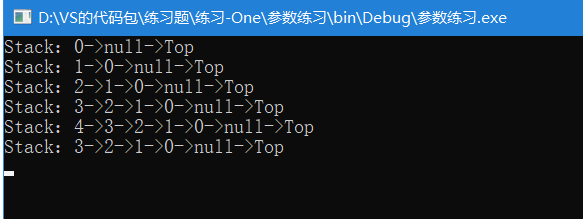
数组栈、链表栈性能对比例子
TestStack方法: 对栈执行N次入栈和出栈操作 对于TestStack方法,不管是测试数组栈还是链表栈它们的时间复杂度都是O(n) 运行时间和数据规模成正比的关系 在Main方法中: 测试不同底层实现的栈性能 ArrayStack和linkedListStack耗时消耗巨大 由于链表的实现需要不断的new空间,所以内存操作耗时较大。 而对于数组操作,是对连续空间进行操作的,C#底层对连续空间的访问有非常好的优化。 再加上数据规模增大以后,动态数组resize调用的频次其实很小,所以得到这个测试结果是正常的:)
class Program
{
public static long TestStack(IStack<int> stack, int N)
{
Stopwatch t = new Stopwatch();
t.Start();
for (int i = 0; i < N; i++)
stack.Push(i);
for (int i = 0; i < N; i++)
stack.Pop();
t.Stop();
return t.ElapsedMilliseconds;
}
private static void Main(string[] args)
{
int n = 10000000;
//ArrayIstack'time:1842ms
ArrayIstack<int> arrayIstack = new ArrayIstack<int>(n);
long t1 = TestStack(arrayIstack, n);
Console.WriteLine("ArrayIstack'time:" + t1 + "ms");
LinkListStack<int> linkListStack = new LinkListStack<int>();
long t2 = TestStack(linkListStack, n);
Console.WriteLine("linkListStack'time:" + t2 + "ms");
//C#提供的栈是基于数组实现的。
Stack<int> stack = new Stack<int>(n);
Stopwatch t = new Stopwatch();
t.Start();
for (int i = 0; i < n; i++)
stack.Push(i);
for (int i = 0; i < n; i++)
stack.Pop();
t.Stop();
Console.WriteLine("Stack'time: " + t.ElapsedMilliseconds + "ms");
Console.ReadKey();
}
}
运行结果:

链表LinkedList1的底层代码:
重点:在链表中,只能通过 一 找到 二 ,没办法从 二 找到 一。
class LinkedList1<E>
{
private class Node
{
public E e;
public Node next;
/// <summary>
/// 指向下一个节点的方法
/// </summary>
/// <param name="e"></param>
/// <param name="next"></param>
public Node(E e, Node next)
{
this.e = e;
this.next = next;
}
/// <summary>
/// 头部的节点
/// </summary>
/// <param name="e"></param>
public Node(E e)
{
this.e = e;
this.next = null;
}
public override string ToString()
{
return e.ToString();
}
}
private Node head;
private int N;
public LinkedList1() {
head = null;
N = 0;
}
public int Count
{
get { return N; }
}
public bool IsEmpty
{
get { return N == 0; }
}
public void Add(int index,E e)
{
if (index < 0 || index > N)
throw new ArgumentException("非法索引");
if (index == 0)
{
//如果index 等于零,那就说明我们将进行头部节点的添加
//原来的头部节点就是新节点的引用指向
//新节点就是新的头部结点
//Node node = new Node(e);
//node.next = head;
//head = node;
head = new Node(e, head);
}
else
{
Node pro = head;
for (int i = 0; i < index - 1; i++)
pro = pro.next;
//.next 意思是:结点的引用指向
//将 for循环遍历后的头部结点指向的引用 变为 新节点的引用指向
//Node node = new Node(e); //新的结点
//node.next = pro.next; //新结点就是 头部节点的引用指向
//pro.next = node;
pro.next = new Node(e, pro.next);
}
N++;
}
public void AddFrist(E e)
{
Add(0, e);
}
public void AddLast(E e)
{
Add(N, e);
}
public E Get(int index)
{
if (index < 0 || index > N)
throw new ArgumentException("非法索引");
Node cur = head;
for (int i = 0; i < index; i++)
cur = cur.next;
return cur.e;
}
public E GetFirst()
{
return Get(0);
}
public E GetLast()
{
return Get(N - 1);
}
public void Set(int index, E newE)
{
if (index < 0 || index > N)
throw new ArgumentException("非法索引");
Node cur = head;
for (int i = 0; i < index; i++)
cur = cur.next;
cur.e = newE;
}
public bool Containa(E e)
{
Node cur = head;
while (cur != null)
{
if (cur.e.Equals(e))
return true;
cur = cur.next;
}
return false;
}
public E RemoveAt(int index)
{
if (index < 0 || index > N)
throw new ArgumentException("非法索引");
if (index == 0)
{
Node DelCur = head;
head = head.next;
N--;
return DelCur.e;
}
else
{
Node pre = head;
for (int i = 0; i < index - 1; i++)
pre = pre.next;
Node delcur = pre.next;
pre.next = delcur.next;
N--;
return delcur.e;
}
}
public E RemoveFirst()
{
return RemoveAt(0);
}
public E RemoveLast()
{
return RemoveAt(N - 1);
}
//两个指针,cur指向头部,pre指向null。
//cur在前,pre在后。
//当cur变成cur.next,那pre就是原来的cur
public void Remove(E e)
{
if (head == null)
return;
if (head.e.Equals(e))
{
head = head.next;
N--;
}
else
{
Node cur = head;
Node pre = null;
while (cur != null)
{
if (cur.e.Equals(e))
break;
pre = cur;
cur = cur.next;
}
if (cur != null)
{
pre.next = pre.next.next;
N--;
}
}
}
public override string ToString()
{
StringBuilder res = new StringBuilder();
Node cur = head;
while (cur!=null)
{
res.Append(cur + "->");
cur = cur.next;
}
res.Append("null");
return res.ToString();
}
}
链表Linked List2的底层代码
与第一代的区别在于,第二代具有尾指针 头:head(默认) 尾:tail 假设我要在尾部添加链表结点元素。 第一代必须通过cur = cur.next,遍历到尾部的前一个然后进行添加,但这样时间复杂度为O(N) 但第二代只需要,tail.next = NewCur , tail= NewCur ,时间复杂度为O(1) 两者在尾部添加数据有差别外,其余的在时间复杂度上没什么区别
//第二版本的链表,具备头尾指针
class LinkedList2<E>
{
private class Node
{
/// <summary>
/// 结点中存储的元素
/// </summary>
public E e;
/// <summary>
/// 存储下一个结点的引用
/// </summary>
public Node next;
/// <summary>
/// 通过元素和下一个结点的引用创建结点
/// </summary>
public Node(E e, Node next)
{
this.e = e;
this.next = next;
}
/// <summary>
///通过元素创建结点
/// </summary>
public Node(E e)
{
this.e = e;
this.next = null;
}
/// <summary>
/// 输出结点的信息
/// </summary>
public override string ToString()
{
return e.ToString();
}
}
private Node head;//头指针标识链表的头部
private Node tail; //尾指针标记链表尾部结点
private int N;
//初始化链表一个结点也没有,head指向空,尾部指针指向空,N为0
public LinkedList2()
{
head = null;
tail = null;
N = 0;
}
public int Count { get { return N; }}
public bool IsEmpty { get { return N == 0; } }
/// <summary>
/// 往链表尾部添加元素
/// </summary>
/// <param name="e"></param>
public void AddLast(E e)
{
Node node = new Node(e);
if (IsEmpty)
{
head = node;
tail = node;
}
else
{
tail.next = node;
tail = node;
}
N++;
}
/// <summary>
/// 删除链表头部结点
/// </summary>
/// <returns></returns>
public E RemoveFirst()
{
if (IsEmpty)
throw new InvalidOperationException("链表为空");
E e = head.e;
head = head.next;
if (head == null)
tail = null;
N--;
return e;
}
/// <summary>
/// 获取链表头部结点
/// </summary>
/// <returns></returns>
public E GetFirst()
{
if (IsEmpty)
{
throw new InvalidOperationException("链表为空");
}
return head.e;
}
public override string ToString()
{
StringBuilder res = new StringBuilder();
Node cur = head;
while (cur != null)
{
res.Append(cur + "->");
cur = cur.next;
}
res.Append("null");
return res.ToString();
}
}
链表LinkedList3的底层代码
不同于第一二代的泛型存储数据,它的存储方式是 字典(Dictionary) 并且有两个变量,Key、Value。同时key、Value是指向关系(Key➡Value),通过Key可以找到对应Value 但是这里 Key 代表存储进来的值,Value 代表该值出现的频率 之所以需要第三代,因为我们想要判断记事本中有多少 Key 以及它出现的频率 value
/// <summary>
/// 第三版的链表类,只具备头指针,存储键值对的数据
/// </summary>
/// <typeparam name="Key">代表存储进来的值</typeparam>
/// <typeparam name="Value">代表存储进来的值,它的频率</typeparam>
class LinkedList3<Key,Value>
{
//私有的内部结点类
//这个类相比较以前的LinkedList1的结点类多存储了一个value变量而已
private class Node
{
public Key key;
public Value value;
public Node next;
public Node(Key key, Value value,Node next)
{
this.key = key;
this.value = value;
this.next = next;
}
public override string ToString()
{
return key.ToString() + " : " + value.ToString();
}
}
private Node head;
private int N;
public LinkedList3()
{
head = null;
N = 0;
}
public int Count { get { return N; } }
public bool IsEmpty { get { return N == 0; } }
/// <summary>
/// 私有的辅助函数,通过键查找对应的结点!
/// 有了它作为前提,能更方便的实现增删改查相应的功能
/// </summary>
private Node GetNode(Key key)
{
Node cur = head;
while (cur != null)
{
if (cur.key.Equals(key))
return cur;
cur = cur.next;
}
return null;
}
/// <summary>
/// 往链表添加键值对数据
/// </summary>
public void Add(Key key, Value value)
{
Node node = GetNode(key);
//如果结点不存在,则创建新节点
if (node == null)
{
head = new Node(key, value, head);
N++;
}
else //存在的话,就更新一下键对应的值
node.value = value;
}
/// <summary>
/// 查看链表中是否包含指定键
/// </summary>
public bool Contains(Key key)
{
return GetNode(key) != null;
}
/// <summary>
/// 通过键获取对应的值
/// </summary>
public Value Get(Key key)
{
Node node = GetNode(key);
if (node == null)
throw new ArgumentException("键" + key + "不存在");
else
return node.value;
}
/// <summary>
/// 将键对应的值改成一个新的值
/// </summary>
public void Set(Key key,Value NewValue)
{
Node node = GetNode(key);
if (node == null)
throw new ArgumentException("键" + key + "不存在");
else
node.value = NewValue;
}
/// <summary>
/// 通过键删除结点中存储的储键值对数据
/// </summary>
public void Remove(Key key)
{
if (head == null)
return;
if (head.key.Equals(key))
{
head = head.next;
N--;
}
else
{
Node cur = head;
Node pre = null;
while (cur != null)
{
if (cur.key.Equals(key))
break;
pre = cur;
cur = cur.next;
}
if (cur != null)
{
pre.next = pre.next.next;
N--;
}
}
}
}
队列的应用
队列(Queue):是一种先进先出的数据结构 只允许在队头删除元素(出队),在队尾添加元素(入队)
在队列中进行添加、删除元素的例子
与数组栈的区别: (1)数组栈可以在头部(时间复杂度O(1))或尾部进行删除元素(时间复杂度O(N)) (2)但队列只能队头进行删除(时间复杂度为O(N))
class Array1Queue<T>:IQueue<T>
{
private Array1<T> arr;
public int Count { get{ return arr.Count; } }
public bool IsEmpty { get{ return arr.IsEmpty; } }
public Array1Queue(int capacity)
{
arr = new Array1<T>(capacity);
}
public Array1Queue()
{
arr = new Array1<T>();
}
/// <summary>
/// 往队列添加元素
/// </summary>
public void Enqueue(T t)
{
arr.AddLast(t);
}
/// <summary>
/// 删除队列的元素
/// </summary>
public T Dequeue()
{
return arr.RemoveFirst();
}
/// <summary>
///查看队列元素
/// </summary>
public T Peek()
{
return arr.GetFirst();
}
public override string ToString()
{
return "Queue:front " + arr.ToString() + "tall";
}
}
class Program
{
private static void Main(string[] args)
{
Array1Queue<int> array1Queue = new Array1Queue<int>();
for (int i = 0; i < 5; i++)
{
array1Queue.Enqueue(i);
Console.WriteLine(array1Queue);
}
array1Queue.Dequeue();
Console.WriteLine(array1Queue);
Console.ReadKey();
}
}
运行结果:
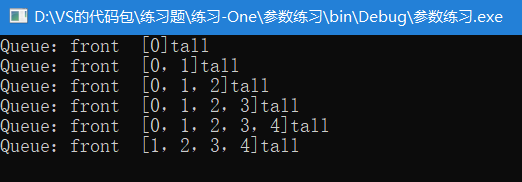
循环队列
因为队列出队是O(N)操作,那为了避免这种情况,循环队列出现了
循环队列的数组,其底层代码:
代码逻辑:假设一个容量(N)为五的数组(data),会有两个索引变量《first》、《last》。 刚初始化时,这两个变量都为零,当我添加元素时,first不变,last++, 如果我想删除元素,我只需要通过数组索引进行删除,然后first++,就行。 假设,目前数组元素是《null》《null》《2》《3》《null》,此时 first 是 data[2], last 是 data[4],当我再次添加元素,last 就会回到 data[0] 如果数组满了,也就是(N == data.length),那旧数组 * 2,然后赋值给新数组 这里有个问题:假设数组元素《7》《8》《3》《4》《5》,赋值到新数组,就应该是《3》《4》《5》《6》《7》《null》《null》《null》《null》《null》 这里 first 的索引指向 data[0],last 索引指向 data[N](这里的 N :旧数组的容量) 这里的代码:for(int i = 0; i<n;i++) newdata[i] = data[first + i] % data.length;
class Array2<E>
{
private E[] data;
private int first;
private int last;
private int N;
public Array2(int capacity)
{
data = new E[capacity];
first = 0;
last = 0;
N = 0;
}
public Array2() : this(10) { }
public int Count { get { return N; } }
public bool IsEmpty { get { return N == 0; } }
public void AddLast(E e)
{
if (N == data.Length)
{
ResetCapacity(data.Length * 2);
}
data[last] = e;
last = (last + 1) % data.Length;
N++;
}
public E RemoveFirst()
{
if (IsEmpty)
throw new InvalidOperationException("数组为空");
if (N == data.Length / 4)
ResetCapacity(data.Length / 2);
E ret = data[first];
data[first] = default(E);
first = (first + 1) % data.Length;
N--;
return ret;
}
public E GetFirst()
{
if (IsEmpty)
throw new InvalidOperationException("数组为空");
return data[first];
}
private void ResetCapacity(int newCapacity)
{
E[] newdata = new E[newCapacity];
for (int i = 0; i < N; i++)
newdata[i] = data[(first + i) % data.Length];
data = newdata;
first = 0;
last = N;
}
public override string ToString()
{
StringBuilder res = new StringBuilder();
res.Append("[");
for (int i = 0; i < N; i++)
{
res.Append(data[(first + i) % data.Length]);
if ((first + i + 1) % data.Length != last)
res.Append(",");
}
res.Append("]");
return res.ToString();
}
}
循环队列的例子:
循环队列的好处:原来数组队列的出队的时间复杂度是O(N),而循环数组队列,其出队的时间复杂度为O(1)。
class Array2Queue<E>:IQueue<E>
{
private Array2<E> arr;
public int Count { get { return arr.Count; } }
public bool IsEmpty { get { return arr.IsEmpty; } }
public Array2Queue(int capacity)
{
arr = new Array2<E>(capacity);
}
public Array2Queue()
{
arr = new Array2<E>();
}
/// <summary>
/// 往队列添加元素
/// </summary>
public void Enqueue(E E)
{
arr.AddLast(E);
}
/// <summary>
/// 删除队列的元素
/// </summary>
public E Dequeue()
{
return arr.RemoveFirst();
}
/// <summary>
///查看队列元素
/// </summary>
public E Peek()
{
return arr.GetFirst();
}
public override string ToString()
{
return "Queue:front " + arr.ToString() + "tall";
}
}
class Program
{
private static void Main(string[] args)
{
#region 往数组队列添加、删除元素
Array2Queue<int> array2Queue = new Array2Queue<int>();
for (int i = 0; i < 5; i++)
{
array2Queue.Enqueue(i);
Console.WriteLine(array2Queue);
}
array2Queue.Dequeue();
Console.WriteLine(array2Queue);
#endregion
Console.ReadKey();
}
}
运行结果:
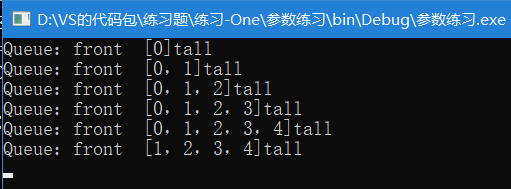
数组队列与循环数组队列的性能对比:
他们之间的区别就是前者出队时间复杂度O(N),后者则为O(1),当数据达到几十万时,他们之间差距就会非常庞大!
class Program
{
public static long TestIQueue(IQueue<int> queue, int N)
{
Stopwatch t = new Stopwatch();
t.Start();
for (int i = 0; i < N; i++)
queue.Enqueue(i);
for (int i = 0; i < N; i++)
queue.Dequeue();
t.Stop();
return t.ElapsedMilliseconds;
}
private static void Main(string[] args)
{
int n = 100000;
Array1Queue<int> array1Queue = new Array1Queue<int>();
long t1 = TestIQueue(array1Queue, n);
Console.WriteLine("Array1Queue'Time'" + t1 + "ms");
Array2Queue<int> array2Queue = new Array2Queue<int>();
long t2 = TestIQueue(array2Queue, n);
Console.WriteLine("Array2Queue'Time'" + t2 + "ms");
Console.ReadKey();
}
}
运行结果:

